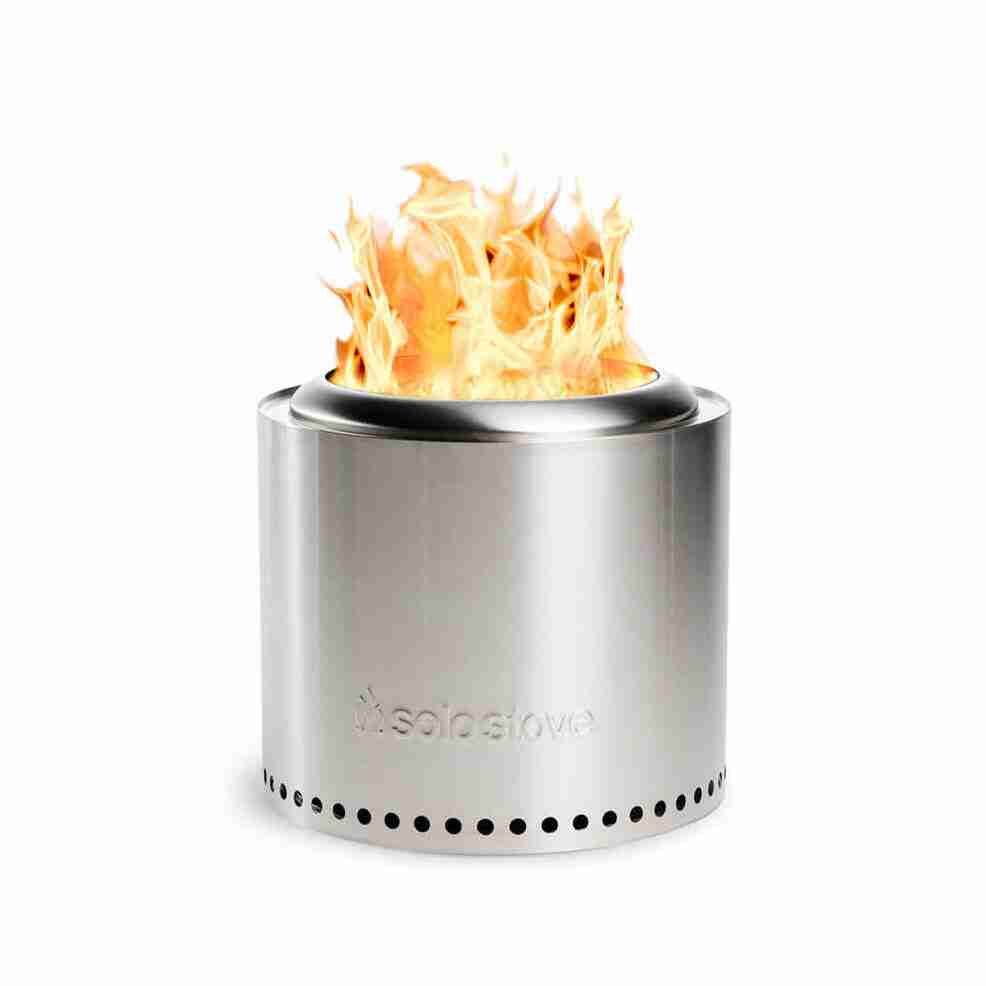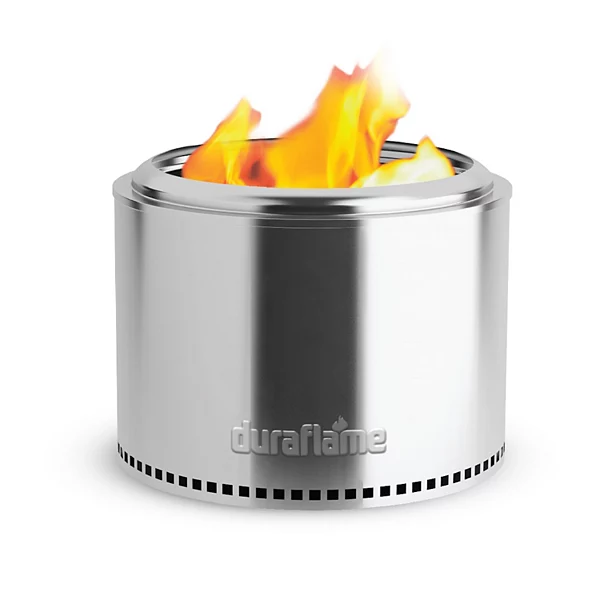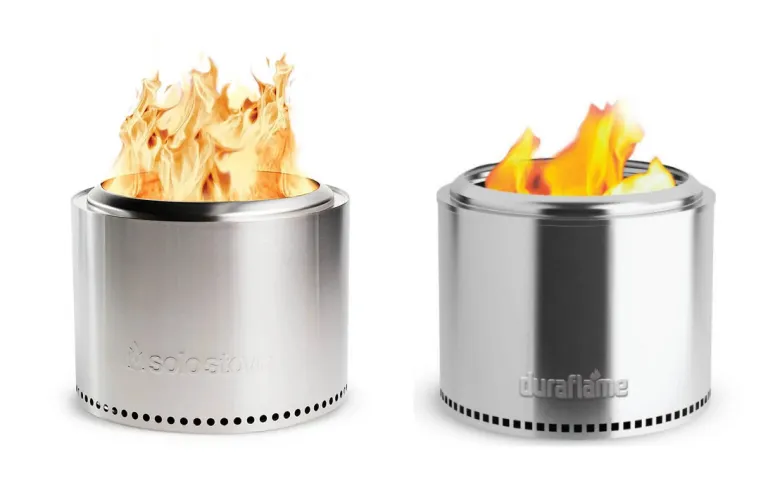As the spring and summer months quickly approach, it sets up the perfect time to enjoy the outdoor space around your home. A great way to enjoy those spaces during these cooler evenings is with a fire pit. But even if you don’t have a permanent fire pit installed, there are portable options that work well and are becoming increasingly popular.
Two top contenders in the market for portable fire pits are the Solo Stove Bonfire and the DuraFlame Smokeless Fire Pit. These two fire pits are very similar in overall design but do have a few differences that customers should be aware of. Below, we’ll look at these two smokeless fire pits and put them head-to-head to see which one may be right for your next backyard gathering or tailgating adventure.
Solo Stove Design And Features

One of the early models that helped launch the popularity of these portable fire pits, the Solo Stove Bonfire is both well-made and stylish. Using solid stainless steel construction, the Solo Stove Bonfire both looks and feels like a sturdy piece of outdoor equipment. But even so, it weighs in at a relatively light 20 pounds so it can be easily transported in most situations.
The Solo Stove Bonfire also comes with a nice custom carrying bag with the Solo Stove logo printed on the side. A nice touch and one that makes transportation or even storage much more convenient.
The Bonfire unit measures 19 inches in diameter and has double-wall construction for strength and smokeless burning. The Bonfire also offers a separate heat deflector which can be attached to the unit, but this is an optional item and not included. The Duraflame unit doesn’t have this option currently.
Finally, the Bonfire does use wood as the fuel source, and using pellets as a fuel source is not possible.
The Solo Stove is currently listed on Amazon for $275.
Duraflame Fire Pit Design And Features

In a very similar design to the Solo Stove (we’ll touch on that later), the Duraflame fire pit should look immediately familiar to anyone who is in the market for the Solo Stove.
The Duraflame model also features full stainless steel construction and comes in just a bit heavier than the Solo Stove at 22 pounds.
The Duraflame model also is slightly larger, with a 19.5-inch diameter that is a half-inch larger than the Solo Stove Bonfire. The size difference isn’t really apparent when using these units.
The Duraflame unit also features double-wall construction for airflow and low smoke burning.
One feature we did like about the Duraflame model is the removable tray for cleaning and removing ash. This feature was recently added to the Solo Stove Bonfire model 2.0, but earlier models needed to be turned upside down to dump the ashes.
Similar to the Solo Stove, the Duraflame uses wood or Duraflame logs and will not accept pellets for fuel.
Finally, the Duraflame model does not come with an included carrying bag, although one is available separately and priced around $35. If you plan on using this around the house, the bag may not be necessary for you. However, for those using these during camping trips or tailgating, the carrying bag definitely comes in handy.
The Duraflame is currently listed on Amazon for $238.
Loading And Getting The Fire Started
Both of these models load very similarly and setting up your fire is the same for both. While the 19-inch size is great, you do have to be somewhat methodical when stacking your wood to make sure you maximize the space allowed within the unit.
To start the fire, we used some natural kindling which only took a few moments to get going. After that, we started adding our wood.
For both models, we found that using wood with a length of about one foot each worked the best. This allowed for good stacking and easy placement within the burn chamber.
Both the Solo Stove and Duraflame produced smoke during the initial burning of the wood. But once the walls heated up the smoke noticeably dropped by as much as 80%.
When filled with wood, we got about two hours of burn time for each unit, although the flame did shrink in size as the fuel source got closer to being exhausted.
Smokeless Performance Comparison
Of course, the big draw of these units besides their portability is the low smoke output. We tested both units with the same wood source and the same kindling and found the smoke performance to be identical.
While no fire pit is 100% smoke-free, these easily reduced the smoke by 80% according to our estimates. The type of wood you use will also have some impact on this, so a little experimentation with different fuel sources may be able to yield even less smoke.
But overall, these two units worked identically and both lived up to the promise of significant smoke reduction.
Ease Of Use
Before the release of the Solo Stove Bonfire 2.0, the Duraflame model had a clear advantage when it came to clean-up. With a removable tray for dumping ashes and cleaning, the Duraflame was the clear winner.
But the new model of the Bonfire now also has this feature, so once again, these two units are extremely similar when it comes to clean-up and removing the built-up ash.
One thing to note though is both these units cannot be left outdoors after use unless they are properly covered. Rain can mix with the ashes and create a corrosive mixture that harms the metal and will significantly reduce the lifespan of both fire pits.
Overall though, both units left very little ash behind due to the smokeless design, and no large chunks at all remained when allowed to burn down all the way.
Solo Stove Bonfire vs Duraflame: Conclusion
As you’ve probably guessed by now, these two units are extremely similar in both design and performance. In fact, they are so similar that a legal battle has broken out between Solo Stove and Duraflame over the design and sales of these units. Thankfully, both models are still available for purchase so this legal fight doesn’t impact the consumer in any way.
Early models of the Solo Stove without the removable tray were definitely a step behind the Duraflame, but now both units share that feature.
We’re not sure how many of the older models of the Solo Stove Bonfire are still in stock, but make sure to look for a 2.0 model.
We have read some complaints about the Duraflame tray warping after repeated fires. However, we didn’t experience this and in even those cases, the tray was replaced under warranty. So this might have only been an issue with early models.
Pricing on these is similar with the Duraflame generally running a bit cheaper, especially during sales. However, the Duraflame fire pit does not come with a carrying bag, so if needed that will add about $35 to the total cost, which may bring it in line with the Solo Stove.
Due to all the similarities, you really can’t go wrong with either of these portable fire pits. The real deciding factor will be price and whether or not the included carrying bag is a necessity for you.
Either way, these are both great options for enjoying a warm fire with friends without all the smoke or expense of a permanent fire pit.

